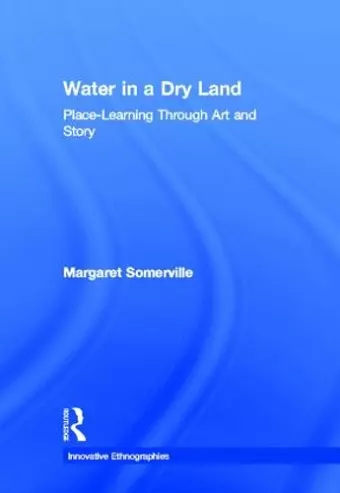Water in a Dry Land
Place-Learning Through Art and Story
Format:Hardback
Publisher:Taylor & Francis Ltd
Published:7th Feb '13
Currently unavailable, and unfortunately no date known when it will be back
This hardback is available in another edition too:
- Paperback£37.99(9780415503976)

Water in a Dry Land is a story of research about water as a source of personal and cultural meaning. The site of this exploration is the iconic river system which forms the networks of natural and human landscapes of the Murray-Darling Basin, Australia. In the current geological era of human induced climate change, the desperate plight of the system of waterways has become an international phenomenon, a symbol of the unsustainable ways we relate to water globally.
The Murray-Darling Basin extends west of the Great Dividing Range that separates the densely populated east coast of Australia from the sparsely populated inland. Aboriginal peoples continue to inhabit the waterways of the great artesian basin and pass on their cultural stories and practices of water, albeit in changing forms. A key question informing the book is: What can we learn about water from the oldest continuing culture inhabiting the world’s driest continent? In the process of responding to this question a team of Indigenous and non-Indigenous researchers formed to work together in a contact zone of cultural difference within an emergent arts-based ethnography.
Photo essays of the artworks and their landscapes offer a visual accompaniment to the text on the Routledge Innovative Ethnography Series website, http://www.innovativeethnographies.net/. This book is perfect for courses in environmental sociology, environmental anthropology, and qualitative methods.
This superbly crafted arts-informed inquiry excels on many levels. Its stories reveal the nuanced specificity of people, places, and cultures while connecting the local with what everyone in the region (and on the planet) shares and needs—water. Methodologically, through her attention to lived experience and artful representation, and conceptually, through her placed entries into the uncertainty of the Anthropocene, Margaret Somerville has created a beautiful and timely book which should be of interest to many students of culture and environment.
-- David Greenwood, Education, Lakehead University
Indigenous engagement with territory is foundational to the way this work demonstrates how human beings, who are more than 50% water, remerge and flow with the land through memory, verse, art story and abiding love of place. Somerville, as an oral historian, has honed the craft of self-reflexivity to parse out ideological dross that might interfere with the voices of the Indigenous People, the re-greening of that fair land and the nourishing of its People.
--Marlene Atleo, Educational Administration, Foundations and Psychology, University of Manitoba
Exquisitely written, this book is about the deep mattering of water, about storylines and Country, flows and places, all sorts of reconciliations, and the enduring significance of art as necessary knowledge, especially in a time of global ecological challenge. It reaches out from its local engagements in Australia to embrace the world. An astonishing work, of great power and beauty.
--Bill Green, Teacher Education, Charles Sturt University
This is a story of water and a writing that longs to be water. A five year collaborative (auto)ethnographic study of drought in Australia, it deals with resource management and embodied arts-based methodologies across cultural differences. A unique and strong-voiced book, it elaborates art and place as public pedagogy, moving between Western and Aboriginal knowledge systems and touching upon deep mapping, sharp tongued women, elusive lakes, and sacred waters.
-- Patti Lather, Education, Ohio State University
Margaret Somerville’s groundbreaking ethnography provides a poetic contact zone that makes meaningful Aboriginal stories and artwork about creative practices of searching for water in the world’s driest continent. Globally we are running out of usable water. Learning from Aboriginal language-and-knowledge, philosophy and the pioneering methodology of ‘thinking through Country’ are integral to understanding the impermance of water. This is a refreshing mapping of Aboriginal storylines of Country.
-- Michael Singh, Education, University of Western Sydney
Margaret Somerville’s work defies categorisation: it is ethnography, poetry, research text and story-telling rolled into one. It is political, humane and engaging in its treatment of that most serious of subjects: water. The original and embodied methodology will provoke social science researchers and students of social science research to rethink the possibilities for knowledge creation, as well as inspiring new ways of working with co-researchers.
--Miriam Zukas, Adult Education, Birkbeck, University of London
Margaret Somerville and the artist/researchers that she collaborates with have created an inspiring posthuman ethnography about water. Water in a dry land is a groundbreaking work that challenges readers to fundamentally shift their thinking about water, about research, relations, and the significance of the more-than-human.
--Mindy Blaise, Early Childhood Education, Hong Kong Institute of Education
Anyone interested in global water sustainability, Indigenous knowledge, or fresh ways to think about learning, land and community will find deep inspiration in Water in a Dry Land. Margaret Somerville provides here a remarkable model of collaborative innovative research with community. Rendered movingly in story, ritual and picture, her study overturns convention to reveal striking new insights and sources of knowing for addressing global water crises. But beyond the provocative scholarship here, Somerville’s profound personal tale of water draws readers into their own "thinking through country" that can transform pedagogy and research.
--Tara Fenwick, Education, University of Stirling
ISBN: 9780415503969
Dimensions: unknown
Weight: 570g
224 pages